It is now = 10:34 in SanFrancisco
= 19:34 in Berlin
W O R L D T I M E C L O C K » K U N D O « (1960)
******************************************************************
( 23 cm Diameter ) Kieninger & Obergfell, St.Georgen / Germany
The world map is shown in "North Polar Projection". GMT is on the
bottom. This "tic-tac" clock has a "balanced spring" mechanic.
A battery powered motor winds up the main spring every 4 minutes
due to a MECHANICAL(!) TIMER. A 12 HOUR FACE shows the LOCAL TIME.
The outer ring with 24 HOURS shows the TIME-ZONES & WORLD CITIES
with DAY & NIGHT.
R E M A R K S :
==================================================================
(A) HOW THE ELECTRO-MECHANICAL K U N D O WORLD CLOCK WORKS:
---------------------------------------------------------------
View without plastic cover / battery holder ...
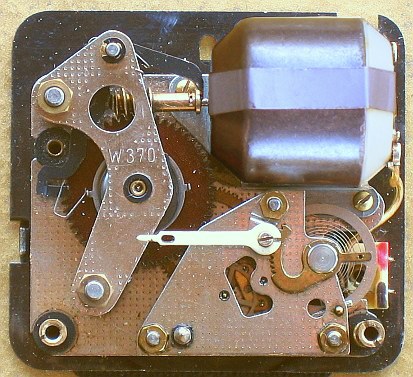 The red/black marks on the right side indicates where the contacts
of the battery are connected when the cover is mounted. From there
cables with clips go direct to the motor. The On/Off-Switch is
INSIDE (!) THE MOTOR. On the Motor-Axle is a HELIX-Gear mounted.
This HELIX drives the PLASTIC-Gear. On its Axle below (s.pic.right)
is the SPRING and a BRASS-Gear, what drives the clock-work.
HOW IT WORKS (s.Pic.left): Inside the PLASTIC-Gear is a RING with a
"Nose-DOWN" through a "Cut-Out" and a PAIR "Noses-UP" on top. From
the BRASS-Gear a ROD (s.>>>> MARK !) pushes the "Nose-DOWN" to the
end of the "Cut-Out"... moves the PLASTIC-Gear... HELIX... Motor-
Axle... Power-ON... Motor ON: The Clock-Spring gets wind. Important
Detail: The "Black-L-LEVER" has a SPRING on its end, touching the
PLASTIC-Gear on a "Nose-UP", building-up TENSION... When released,
the L-LEVER push HELIX... Motor get power, turns and "over-shoot"
until the PLASTIC-Gear stop and the Motor-Axle will return to idle
(=OFF)Position. This assembly works as a MECHANICAL-TIMER.
The red/black marks on the right side indicates where the contacts
of the battery are connected when the cover is mounted. From there
cables with clips go direct to the motor. The On/Off-Switch is
INSIDE (!) THE MOTOR. On the Motor-Axle is a HELIX-Gear mounted.
This HELIX drives the PLASTIC-Gear. On its Axle below (s.pic.right)
is the SPRING and a BRASS-Gear, what drives the clock-work.
HOW IT WORKS (s.Pic.left): Inside the PLASTIC-Gear is a RING with a
"Nose-DOWN" through a "Cut-Out" and a PAIR "Noses-UP" on top. From
the BRASS-Gear a ROD (s.>>>> MARK !) pushes the "Nose-DOWN" to the
end of the "Cut-Out"... moves the PLASTIC-Gear... HELIX... Motor-
Axle... Power-ON... Motor ON: The Clock-Spring gets wind. Important
Detail: The "Black-L-LEVER" has a SPRING on its end, touching the
PLASTIC-Gear on a "Nose-UP", building-up TENSION... When released,
the L-LEVER push HELIX... Motor get power, turns and "over-shoot"
until the PLASTIC-Gear stop and the Motor-Axle will return to idle
(=OFF)Position. This assembly works as a MECHANICAL-TIMER.
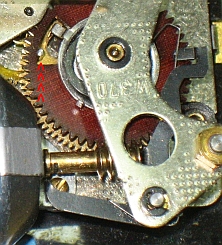 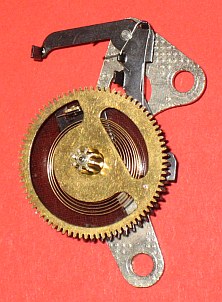 (B) REPAIR / RESTORATION:
-------------------------
(1)
Nothing worked - also not after oiling and cleaning contacts ...
(2)
To open the motor a little force was necessary - and 2 hidden
pins, holding the axle/contact plate, cracked its plastic. Now
the V-shaped inner contacts where visible and obvious unable to
touch the collector of the motor. Shaped it right with trial-and-
error: They have to give contact when the axle is in its right
position, and out of contact otherwise. 2 CLIPS, made out of CAT
FOOD CAN ( fixed with tape ), holding in place the plastic plate
on the cast metal motor housing.
(3)
The helix-gear was loose and needed a new connection: On the
motor axle is a one-turn spring mounted and through the slot of
the helix-gear fixed. The exact position of the helix-gear on the
axle is part of the fine-tuning procedure ...
(4)
The Tuning-Procedure had to be made with an AmpMeter "In-the-Loop"
to make sure, that the Motor-On/Off is working perfect. To make the
»KUNDO« working again is difficult (+ time-consuming) because many
parameters have to be adjust "right" at the same time ...
(B) REPAIR / RESTORATION:
-------------------------
(1)
Nothing worked - also not after oiling and cleaning contacts ...
(2)
To open the motor a little force was necessary - and 2 hidden
pins, holding the axle/contact plate, cracked its plastic. Now
the V-shaped inner contacts where visible and obvious unable to
touch the collector of the motor. Shaped it right with trial-and-
error: They have to give contact when the axle is in its right
position, and out of contact otherwise. 2 CLIPS, made out of CAT
FOOD CAN ( fixed with tape ), holding in place the plastic plate
on the cast metal motor housing.
(3)
The helix-gear was loose and needed a new connection: On the
motor axle is a one-turn spring mounted and through the slot of
the helix-gear fixed. The exact position of the helix-gear on the
axle is part of the fine-tuning procedure ...
(4)
The Tuning-Procedure had to be made with an AmpMeter "In-the-Loop"
to make sure, that the Motor-On/Off is working perfect. To make the
»KUNDO« working again is difficult (+ time-consuming) because many
parameters have to be adjust "right" at the same time ...
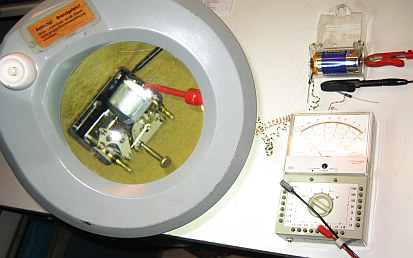 powered by a 1.5 Volt D-Cell
impressum:
******************************************************************
© C.HAMANN http://public.BHT-Berlin.de/hamann 12/14/14
powered by a 1.5 Volt D-Cell
impressum:
******************************************************************
© C.HAMANN http://public.BHT-Berlin.de/hamann 12/14/14
|
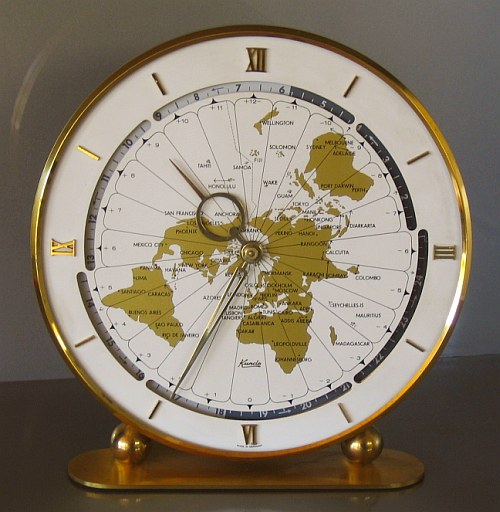
 The red/black marks on the right side indicates where the contacts
of the battery are connected when the cover is mounted. From there
cables with clips go direct to the motor. The On/Off-Switch is
INSIDE (!) THE MOTOR. On the Motor-Axle is a HELIX-Gear mounted.
This HELIX drives the PLASTIC-Gear. On its Axle below (s.pic.right)
is the SPRING and a BRASS-Gear, what drives the clock-work.
HOW IT WORKS (s.Pic.left): Inside the PLASTIC-Gear is a RING with a
"Nose-DOWN" through a "Cut-Out" and a PAIR "Noses-UP" on top. From
the BRASS-Gear a ROD (s.>>>> MARK !) pushes the "Nose-DOWN" to the
end of the "Cut-Out"... moves the PLASTIC-Gear... HELIX... Motor-
Axle... Power-ON... Motor ON: The Clock-Spring gets wind. Important
Detail: The "Black-L-LEVER" has a SPRING on its end, touching the
PLASTIC-Gear on a "Nose-UP", building-up TENSION... When released,
the L-LEVER push HELIX... Motor get power, turns and "over-shoot"
until the PLASTIC-Gear stop and the Motor-Axle will return to idle
(=OFF)Position. This assembly works as a MECHANICAL-TIMER.
The red/black marks on the right side indicates where the contacts
of the battery are connected when the cover is mounted. From there
cables with clips go direct to the motor. The On/Off-Switch is
INSIDE (!) THE MOTOR. On the Motor-Axle is a HELIX-Gear mounted.
This HELIX drives the PLASTIC-Gear. On its Axle below (s.pic.right)
is the SPRING and a BRASS-Gear, what drives the clock-work.
HOW IT WORKS (s.Pic.left): Inside the PLASTIC-Gear is a RING with a
"Nose-DOWN" through a "Cut-Out" and a PAIR "Noses-UP" on top. From
the BRASS-Gear a ROD (s.>>>> MARK !) pushes the "Nose-DOWN" to the
end of the "Cut-Out"... moves the PLASTIC-Gear... HELIX... Motor-
Axle... Power-ON... Motor ON: The Clock-Spring gets wind. Important
Detail: The "Black-L-LEVER" has a SPRING on its end, touching the
PLASTIC-Gear on a "Nose-UP", building-up TENSION... When released,
the L-LEVER push HELIX... Motor get power, turns and "over-shoot"
until the PLASTIC-Gear stop and the Motor-Axle will return to idle
(=OFF)Position. This assembly works as a MECHANICAL-TIMER.

 (B) REPAIR / RESTORATION:
-------------------------
(1)
Nothing worked - also not after oiling and cleaning contacts ...
(2)
To open the motor a little force was necessary - and 2 hidden
pins, holding the axle/contact plate, cracked its plastic. Now
the V-shaped inner contacts where visible and obvious unable to
touch the collector of the motor. Shaped it right with trial-and-
error: They have to give contact when the axle is in its right
position, and out of contact otherwise. 2 CLIPS, made out of CAT
FOOD CAN ( fixed with tape ), holding in place the plastic plate
on the cast metal motor housing.
(3)
The helix-gear was loose and needed a new connection: On the
motor axle is a one-turn spring mounted and through the slot of
the helix-gear fixed. The exact position of the helix-gear on the
axle is part of the fine-tuning procedure ...
(4)
The Tuning-Procedure had to be made with an AmpMeter "In-the-Loop"
to make sure, that the Motor-On/Off is working perfect. To make the
»KUNDO« working again is difficult (+ time-consuming) because many
parameters have to be adjust "right" at the same time ...
(B) REPAIR / RESTORATION:
-------------------------
(1)
Nothing worked - also not after oiling and cleaning contacts ...
(2)
To open the motor a little force was necessary - and 2 hidden
pins, holding the axle/contact plate, cracked its plastic. Now
the V-shaped inner contacts where visible and obvious unable to
touch the collector of the motor. Shaped it right with trial-and-
error: They have to give contact when the axle is in its right
position, and out of contact otherwise. 2 CLIPS, made out of CAT
FOOD CAN ( fixed with tape ), holding in place the plastic plate
on the cast metal motor housing.
(3)
The helix-gear was loose and needed a new connection: On the
motor axle is a one-turn spring mounted and through the slot of
the helix-gear fixed. The exact position of the helix-gear on the
axle is part of the fine-tuning procedure ...
(4)
The Tuning-Procedure had to be made with an AmpMeter "In-the-Loop"
to make sure, that the Motor-On/Off is working perfect. To make the
»KUNDO« working again is difficult (+ time-consuming) because many
parameters have to be adjust "right" at the same time ...
 powered by a 1.5 Volt D-Cell
powered by a 1.5 Volt D-Cell